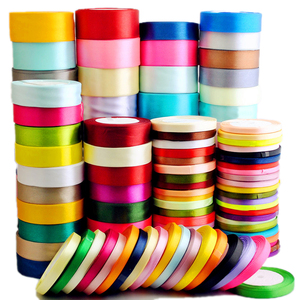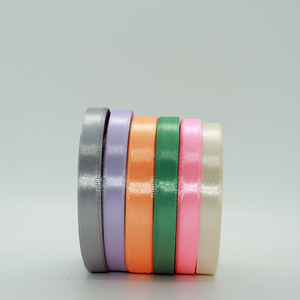
All categories
Featured selections
Trade Assurance
Buyer Central
Help Center
Get the app
Become a supplier

(21494 products available)













































Silk satin is manufactured from natural silk fibers. It is one of the most luxurious satin types on the market. This fabric has a characteristic glossy surface. The surface is more pronounced on one side than on the other. This gives it a sumptuous look and feel. Also, silk satin drapes incredibly well, making it a popular choice for evening gowns. Other applications include bridalwear, and high-end loungewear. The fabric feels exceptionally soft against the skin and has the ability to keep one warm.
This synthetic satin variant includes polyester, acetate, and nylon satin. These silks may mimic the luxurious appearance and feel of silk satin yet are less expensive. They are more durable and simpler to care for. Glossy or matte finish can be found in synthetic satin fabrics that have a glossy or matte finish. They are therefore suitable for a variety of fashion and home décor applications. These applications include budget-friendly evening gowns, dance costumes, and upholstery. However, even though they may imitate silk's appearance, their breathability and drape are not as good.
This satin has a less shiny surface than silk satin, which gives it a more understated appearance. It is, however, no less sophisticated. The subtle sheen of matte satin fabric gives garments a unique and delicate touch. It is therefore a popular choice for bridal gowns, evening dresses, and formal wear. Moreover, despite its soft finish, it is less likely to slip or wrinkle. Hence, it provides comfortable wear and easy maintenance.
Stretch satin incorporates elastic fibers like spandex or elastane. They add a degree of stretch to the material. This satin variation is especially useful for formal dresses and garments. These garments require both elegance and comfort. The fabric contours nicely to the body, allowing for freedom of movement. This makes it an excellent choice for fitted styles. Often seen in dancewear and evening gowns, satin allows elegance and comfort to coexist.
Face satin is a versatile and luxurious fabric. It is ideal for creating high-end garments and home décor pieces. This fabric is characterized by its smooth, glossy surface on one side and a matte finish on the other. This feature makes it adaptable for various design styles. Also, it is constructed from a mix of fibers such as polyester and silk. It combines durability with a rich, elegant feel. It is also commonly used in upholstery projects due to its resilience and aesthetic appeal. This makes it ideal for both light and heavy applications.
Satin fabric has several features that make it quite popular. Key among them include:
Carefully following maintenance steps is crucial, as each type of satin has specific care instructions. These instructions include:
Satin cloth is extensively used in the fashion industry. Most commonly used is silk satin, which is prized for its luxurious feel and gleam. The rich sheen of silk satin enhances the beauty of evening gowns, making these gowns the go-to fabric for formal wear. The fabric easily drapes as the fabric flows elegantly, thereby creating flattering silhouettes that boost the wearer's figure. Satin is also used in bridal satin, adding a touch of romance to wedding dresses with a polished and elegant appearance.
Satin is a common fabric in lingerie and sleepwear. Its soft and smooth texture feels great against the skin. This makes it ideal for creating comfortable yet sexy pieces. Silk satin and polyester satin are frequently used in making camisoles, robes, and pajamas. The satin sheets are also popular. They are used in sleepwear as they feel cool to the touch. This enhances luxurious loungewear that is both breathability and indulgent.
Beyond clothing, satin is widely used in home décor items. For instance, satin pillowcases can be found in satin pillowcases. They promote healthier hair and skin by reducing friction during sleep. Also, satin curtains add an element of sophistication to living spaces with their glossy finish. They catch the light and create a warm ambiance. Additionally, satin table linens such as table runners and cloths elevate the style of dining areas for special occasions, providing a polished and inviting look.
Satin fabric is also used in accessories such as bags, headbands, and scrunchies. These accessories are fashionable and practical. The fabric's ability to hold color vibrancy allows for the creation of eye-catching pieces. Fashion designers frequently incorporate satin into seasonal collections, especially in items where the lightweight and adaptable features of the fabric are required. Indeed, satin lends itself to a variety of uses. It spans from high-end couture to everyday accessories thereby proving its versatility and appeal.
Considering the purpose is vital when choosing a satin fabric. For instance, satin fabric by the yard that is supposed to be used for clothing such as dresses and skirts should, ideally be, silk or polyester satin. Silk satin has a luxurious feel that is ideal for evening gowns and formal wear. On the other hand, polyester satin is a more affordable option that is ideal for various clothing as it is durable. Satin fabric for home décor items such as cushions and curtains should ideally have a heavier weight. They should also be materials with a high durability such as polyester satin.
The texture of the satin fabric can be quite a determining factor on how it feels and hangs when it is used. Lightweight satin, such as charmeuse, has a beautiful drape but may prone to wrinkles. They are ideal for items that do not require much handling like silk curtains. On the other hand, heavier satin, such as duchess satin, has more body and is ideal for structured garments like gowns. Additionally, lighter satin fabrics like silk and polyester require more care when cleaning them. They should be dry cleaned. On the other hand, heavier satin like acetate and nylon can be machine-washed to simplify their maintenance.
Satin fabrics normally come in a broad spectrum of colors and finishes. The finishing of the fabric will impact its appearance and feel. Glossy satin fabrics reflect light more intensely, giving them a luxurious and sleek appearance. This makes them ideal for formal wear and special events. Matte satin, on the other hand, offers a more subdued look. Instead, they are better for everyday apparel or home décor where a subtle elegance is desirable. Also, the availability of satin fabrics in a wide range of colors allows one to match them with a theme or personal preference. For instance, rich jewel tones or classic blacks and navies add sophistication. However, vibrant colors like reds or pastels will always make a statement.
A1. While satin can be used for outdoor application, it is better to use satin with UV-resistant treatments. Also, outdoor satin fabrics should be heavy-weight and durable.
A2. Yes. Satin is generally known for its skin benefits. This is because the material is smooth and has less friction. It causes lesser irritation on the skin when compared to other fabrics.
A3. The major difference between satin and sateen is the fibers used to make them. Satin is normally made from silk, polyester, or nylon. On the other hand, sateen is made from cotton.
A4. Yes. Satin is ideal for summer clothing as it is lightweight and breathable. Though it tends to be warmer against the skin, which can trap heat.
A5. Due to its luxurious shine and smooth texture, satin is quite popular for evening wear. It is because these two characteristics add an element of sophistication to formal dresses.